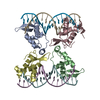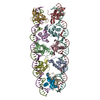+Search query
-Structure paper
| Title | FOXP3 recognizes microsatellites and bridges DNA through multimerization. |
|---|---|
| Journal, issue, pages | Nature, Vol. 624, Issue 7991, Page 433-441, Year 2023 |
| Publish date | Nov 29, 2023 |
 Authors Authors | Wenxiang Zhang / Fangwei Leng / Xi Wang / Ricardo N Ramirez / Jinseok Park / Christophe Benoist / Sun Hur /  |
| PubMed Abstract | FOXP3 is a transcription factor that is essential for the development of regulatory T cells, a branch of T cells that suppress excessive inflammation and autoimmunity. However, the molecular ...FOXP3 is a transcription factor that is essential for the development of regulatory T cells, a branch of T cells that suppress excessive inflammation and autoimmunity. However, the molecular mechanisms of FOXP3 remain unclear. Here we here show that FOXP3 uses the forkhead domain-a DNA-binding domain that is commonly thought to function as a monomer or dimer-to form a higher-order multimer after binding to TG repeat microsatellites. The cryo-electron microscopy structure of FOXP3 in a complex with TG repeats reveals a ladder-like architecture, whereby two double-stranded DNA molecules form the two 'side rails' bridged by five pairs of FOXP3 molecules, with each pair forming a 'rung'. Each FOXP3 subunit occupies TGTTTGT within the repeats in a manner that is indistinguishable from that of FOXP3 bound to the forkhead consensus motif (TGTTTAC). Mutations in the intra-rung interface impair TG repeat recognition, DNA bridging and the cellular functions of FOXP3, all without affecting binding to the forkhead consensus motif. FOXP3 can tolerate variable inter-rung spacings, explaining its broad specificity for TG-repeat-like sequences in vivo and in vitro. Both FOXP3 orthologues and paralogues show similar TG repeat recognition and DNA bridging. These findings therefore reveal a mode of DNA recognition that involves transcription factor homomultimerization and DNA bridging, and further implicates microsatellites in transcriptional regulation and diseases. |
 External links External links |  Nature / Nature /  PubMed:38030726 / PubMed:38030726 /  PubMed Central PubMed Central |
| Methods | EM (single particle) |
| Resolution | 3.3 - 3.7 Å |
| Structure data | EMDB-40736, PDB-8sro: EMDB-40737, PDB-8srp: |
| Source |
|
 Keywords Keywords | TRANSCRIPTION/DNA / FoxP3 / STRs / transcriptional factor / FKH / TRANSCRIPTION / TRANSCRIPTION-DNA complex |
 Movie
Movie Controller
Controller Structure viewers
Structure viewers About Yorodumi Papers
About Yorodumi Papers








